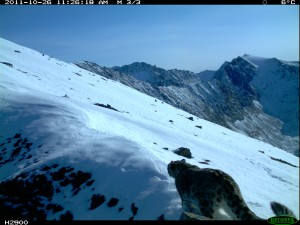
Cameras supplied by SUNY College of Environmental Science and Forestry (ESF) researchers have captured the first images of elusive snow leopards in a remote mountain range in Siberia.
The cameras, equipped with motion sensors, captured photos of two snow leopards on a ridge in the Altai Mountains along the Russia-Mongolia border.
“To get a picture is really a big deal,” said Dr. James P. Gibbs, an ESF conservation biologist ,who is involved in several research projects involving snow leopards. “The signs that the species is in this region are definitive but a picture is irrefutable.”
The photos were taken between Oct. 26 and 30 at an altitude of about 4,000 meters at a location called Chikhachyova Ridge in the Altai Republic, a semiautonomous region in southern Russia. Gibbs said the animals are probably part of a larger population that extends into Mongolia.
Ten cameras were installed in the area as the result of evidence that was found during an expedition this past summer. Gibbs made the trip with Dr. Jacqueline Frair, an ESF wildlife ecologist, and three ESF graduate students: James Arrigoni, Meredith Atwood and Elizabeth Hunter.
The main reason for the trip was to survey the population of Argali sheep, the world’s largest wild sheep species that is threatened by hunting and habitat loss. But the researchers did double duty, searching at the same time for evidence of snow leopards.
“Snow leopards leave clear signs that you see readily if you look for them,” Gibbs said. “You can find scat and places where they scratch trees with their claws. And you see their scrapes, circular depressions made in the gravel that are slightly discolored. They maintain these scent marks. If you see fresh ones, you know snow leopards are in the area.”
The snow leopard population is threatened by poachers who hunt the animals for their distinctive spotted coats.
Gibbs said ESF supplied the high-tech cameras through a $20,000 grant from Panthera, a conservation organization that focuses on saving wild cats. In addition to the snow leopards, the cameras caught images of a rarely seen Pallas cat, also called a manul, a thick-furred feline about the size of a domestic cat.
The expedition that installed the cameras was sponsored jointly by Arkhar and Altaisky State Biosphere Reserve. Staff members from the reserve were accompanied by staff from Ubsunurskaya Basin Biosphere Reserve in Tyva Republic and Mongolian specialists from Silkkhemin Nuru National Park and the World Wildlife Fund (WWF) in Mongolia.
In addition to aid from ESF and Panthera in supplying cameras, the expedition received support from the Snow Leopard Conservancy and WWF-Russia.
The cameras will track snow leopard movements on the ridge throughout the winter and help scientists evaluate the number of animals in the population.

